Yo, dive into the world of Mindfulness Exercises where we explore ways to boost mental well-being and inner peace. From beginner tips to incorporating these exercises into your daily routine, get ready to level up your mindfulness game!
What are Mindfulness Exercises?
Mindfulness exercises are practices that help individuals focus on the present moment and cultivate a state of awareness. These exercises are designed to help reduce stress, improve concentration, and promote overall well-being.
Benefits of Mindfulness Exercises
- Reduce stress and anxiety levels
- Improve focus and concentration
- Enhance self-awareness
- Promote emotional regulation
Examples of Common Mindfulness Exercises
- Deep breathing exercises
- Body scan meditation
- Walking meditation
- Yoga
How Mindfulness Exercises Improve Mental Well-Being
Mindfulness exercises can improve mental well-being by helping individuals become more aware of their thoughts and emotions without judgment. This can lead to a greater sense of clarity, emotional balance, and resilience in facing life’s challenges.
Types of Mindfulness Exercises

When it comes to mindfulness exercises, there are various types that can help you cultivate awareness and focus in your daily life. Each type offers unique benefits and can be practiced in different ways. Let’s explore some of the common types of mindfulness exercises below.
Body Scan
- During a body scan, you focus your attention on different parts of your body, starting from your toes and moving up to your head.
- You pay close attention to any sensations or feelings you may experience without judgment.
- This exercise helps you become more in tune with your body and can promote relaxation and stress relief.
Mindful Breathing
- In mindful breathing exercises, you concentrate on your breath as it goes in and out of your body.
- You can count your breaths or focus on the rise and fall of your abdomen with each breath.
- This practice can help calm your mind, increase focus, and reduce anxiety.
Loving-Kindness Meditation
- Loving-kindness meditation involves sending positive thoughts and feelings of compassion to yourself and others.
- You can repeat phrases like “May I be happy, may I be healthy, may I be at peace” to cultivate feelings of kindness and empathy.
- This exercise can enhance feelings of connection, gratitude, and overall well-being.
Personal Experiences
- Personally, I have found the body scan exercise to be particularly effective in helping me relax and release tension in my body.
- On the other hand, mindful breathing has been instrumental in improving my focus and concentration during busy days.
- Practicing loving-kindness meditation has allowed me to cultivate a sense of compassion and understanding towards myself and others.
Mindfulness Exercises for Beginners
Starting mindfulness exercises as a beginner can be a rewarding journey towards better mental health and overall well-being. Here are some step-by-step tips to help you get started and maintain consistency in your practice.
Starting Your Practice
When beginning mindfulness exercises, it’s important to start with short sessions to avoid feeling overwhelmed. Set aside a specific time each day for your practice and find a quiet space where you can focus without distractions.
- Begin with simple breathing exercises to help you center your mind and body.
- Focus on the present moment without judgment, letting go of worries about the past or future.
- Start with guided meditations or mindfulness apps to help you stay on track.
Maintaining Consistency, Mindfulness Exercises
Consistency is key when it comes to mindfulness practice. Here are some tips to help you stay committed to your daily routine.
- Set reminders on your phone or calendar to ensure you don’t forget your practice sessions.
- Practice self-compassion and be gentle with yourself on days when you struggle to focus.
- Find a community or support group to share your experiences and stay motivated.
Overcoming Challenges
As a beginner, you may face challenges such as restlessness, difficulty concentrating, or skepticism about the practice. Here are some ways to overcome these obstacles.
- Start with shorter sessions and gradually increase the duration as you become more comfortable.
- Practice mindfulness in different settings to see what works best for you.
- Remind yourself that mindfulness is a skill that takes time to develop, and progress may not always be linear.
Success Stories
Many individuals have experienced positive changes in their lives after starting mindfulness exercises. Here are some success stories to inspire you on your own journey.
-
“I used to struggle with anxiety, but since incorporating mindfulness into my daily routine, I’ve noticed a significant reduction in my stress levels and improved sleep quality.”
-
“Mindfulness has helped me become more present and appreciative of the little moments in life. I no longer feel overwhelmed by my emotions and can approach challenges with a clear mind.”
Incorporating Mindfulness Exercises into Daily Routine

To truly reap the benefits of mindfulness, it is essential to integrate mindfulness exercises into your daily routine. By making mindfulness a habit, you can experience improved mental clarity, emotional balance, and overall well-being.
Importance of Integrating Mindfulness Exercises
- Start your day with a mindfulness practice to set a positive tone for the rest of the day.
- Take short mindfulness breaks throughout the day to refocus and recharge.
- Incorporate mindfulness into daily activities such as eating, walking, or even cleaning.
Impact of Regular Mindfulness Practice
-
Regular mindfulness practice can reduce stress, anxiety, and improve focus and memory.
-
It can enhance self-awareness and help you better understand your thoughts and emotions.
-
Mindfulness can improve relationships by fostering better communication and empathy.
Strategies for Making Mindfulness Exercises a Habit
- Set a specific time each day for your mindfulness practice to establish a routine.
- Start with short sessions and gradually increase the duration as you become more comfortable.
- Use reminders or cues, such as a mindfulness bell or a sticky note, to prompt your practice.






